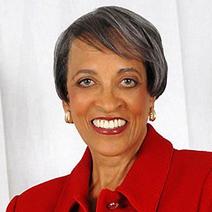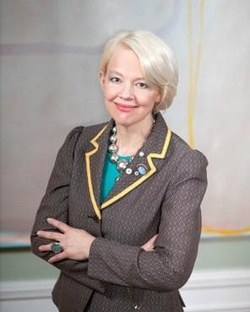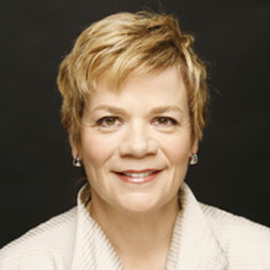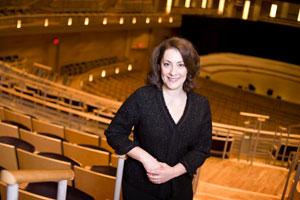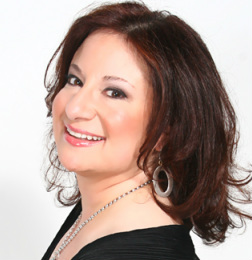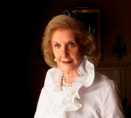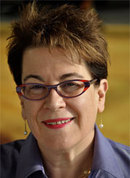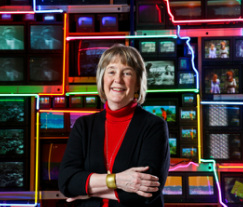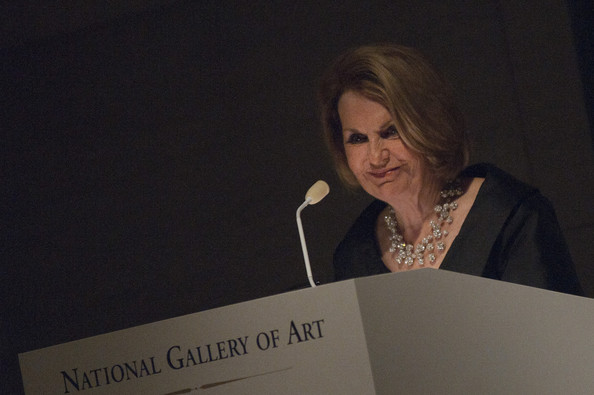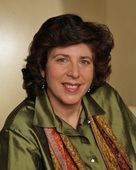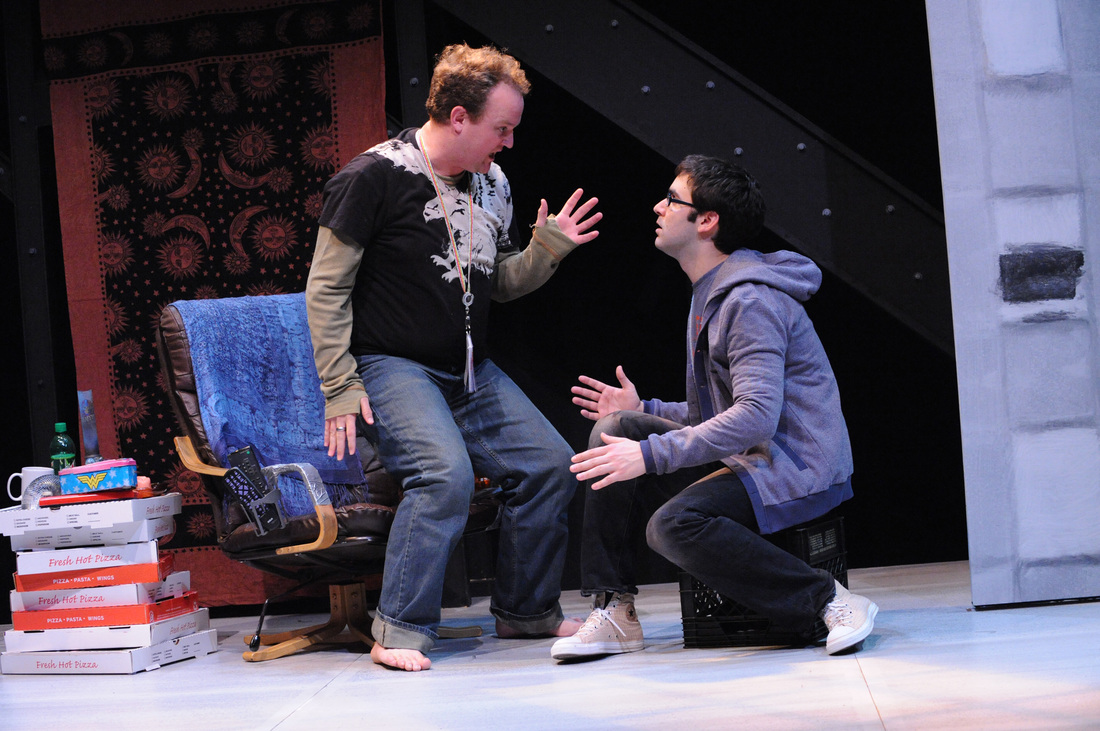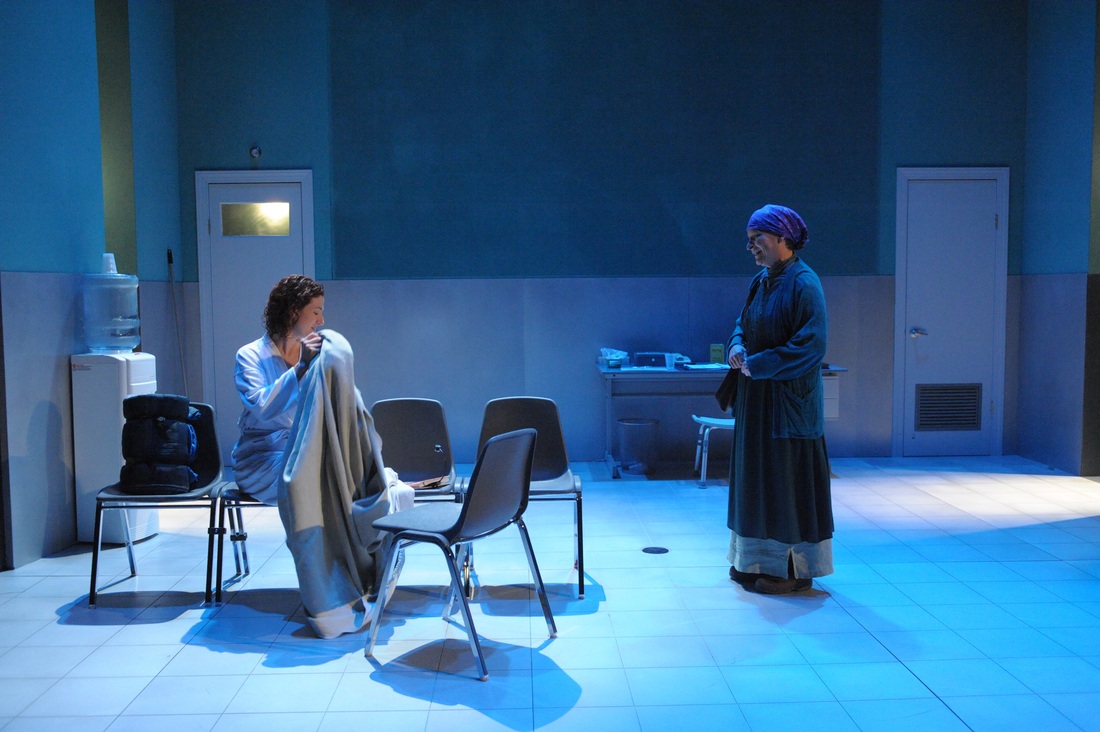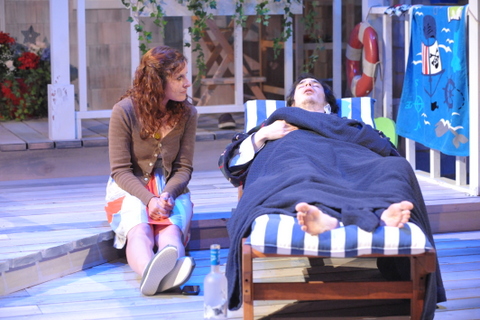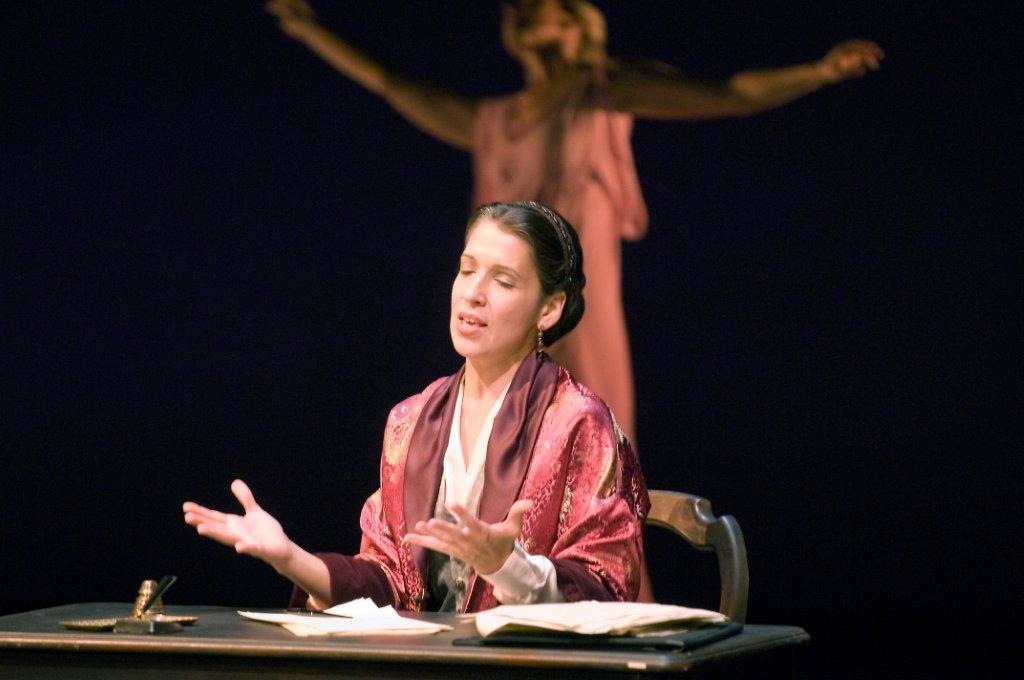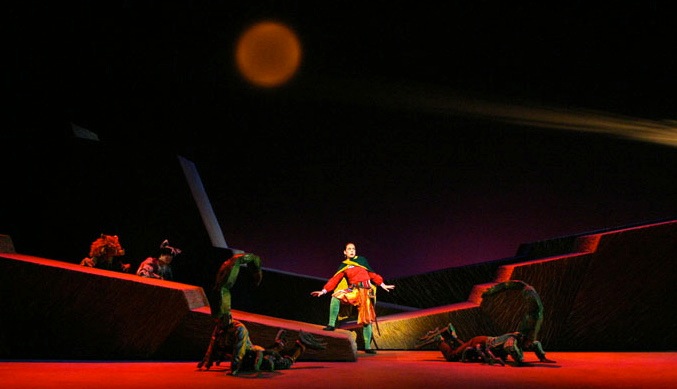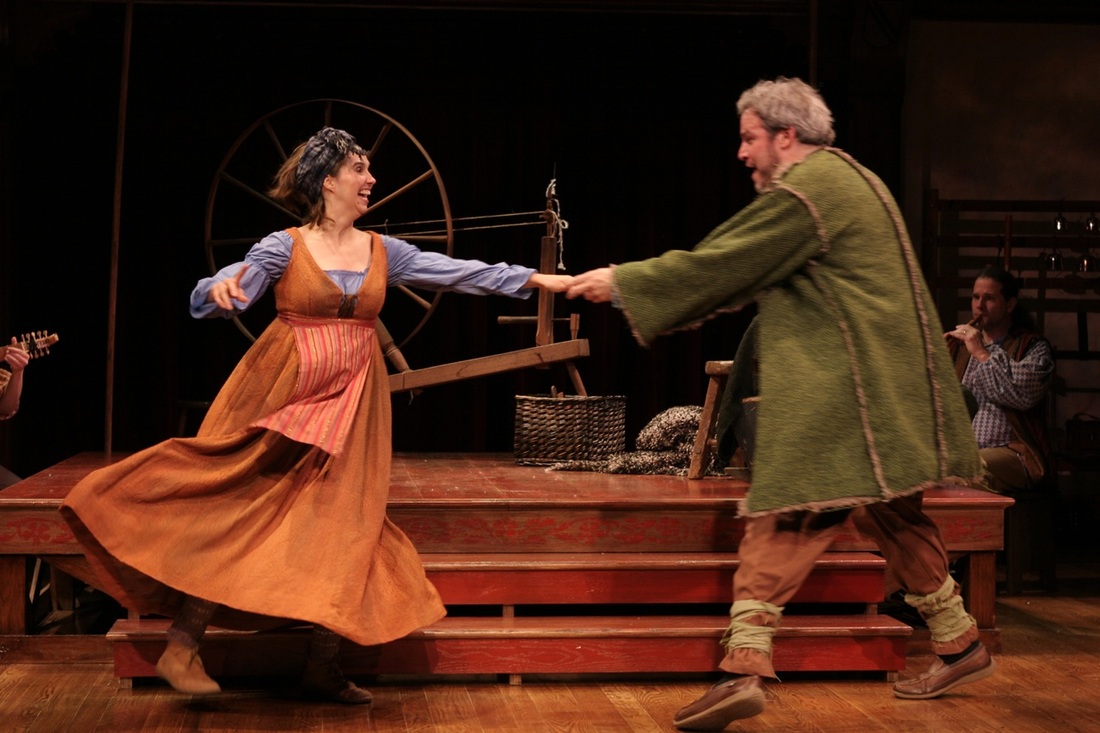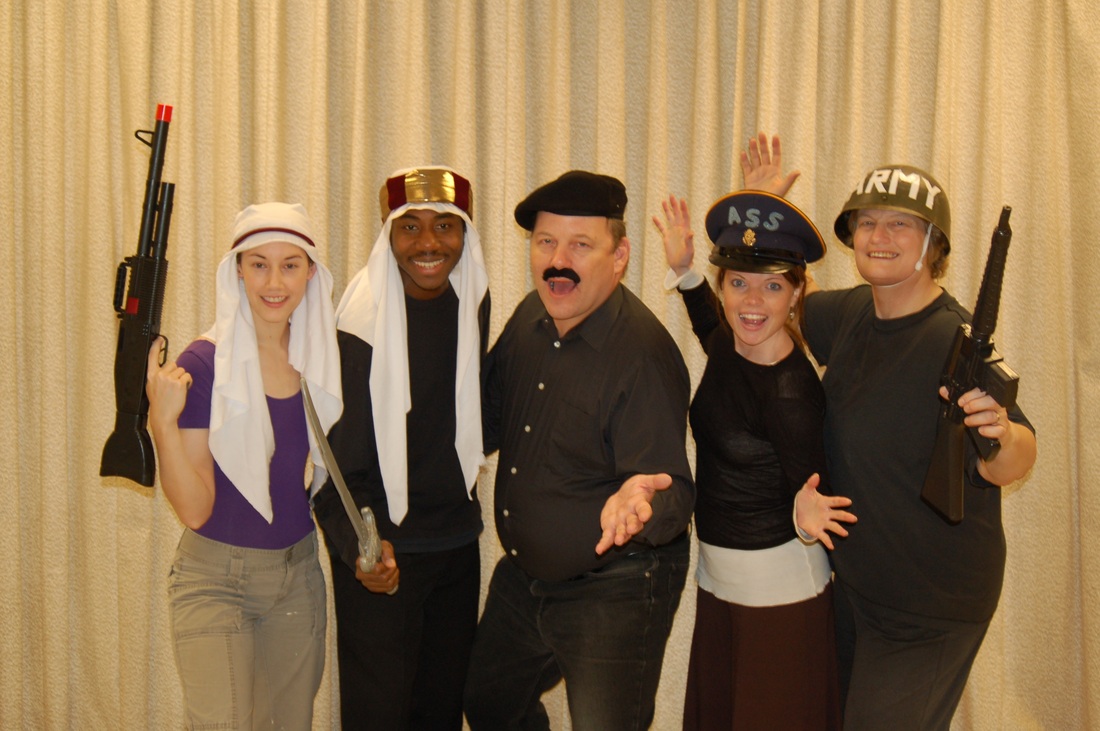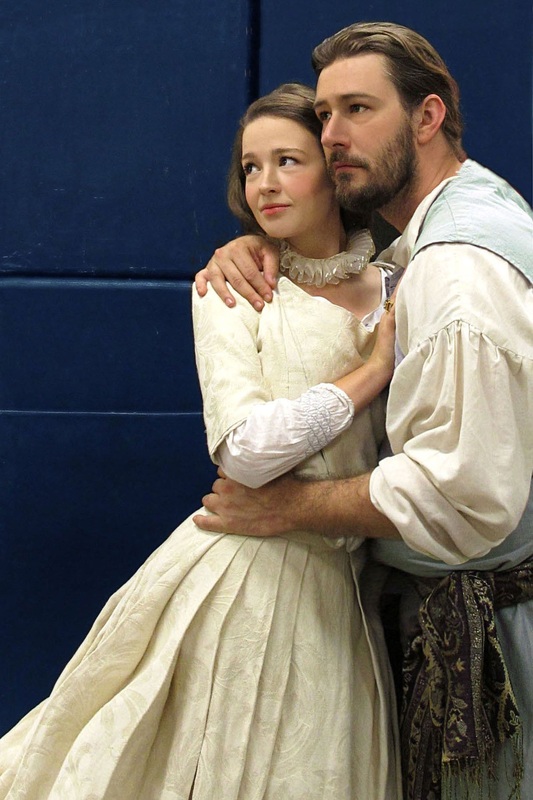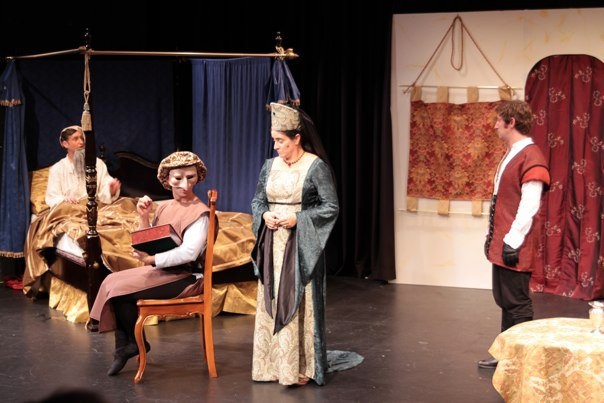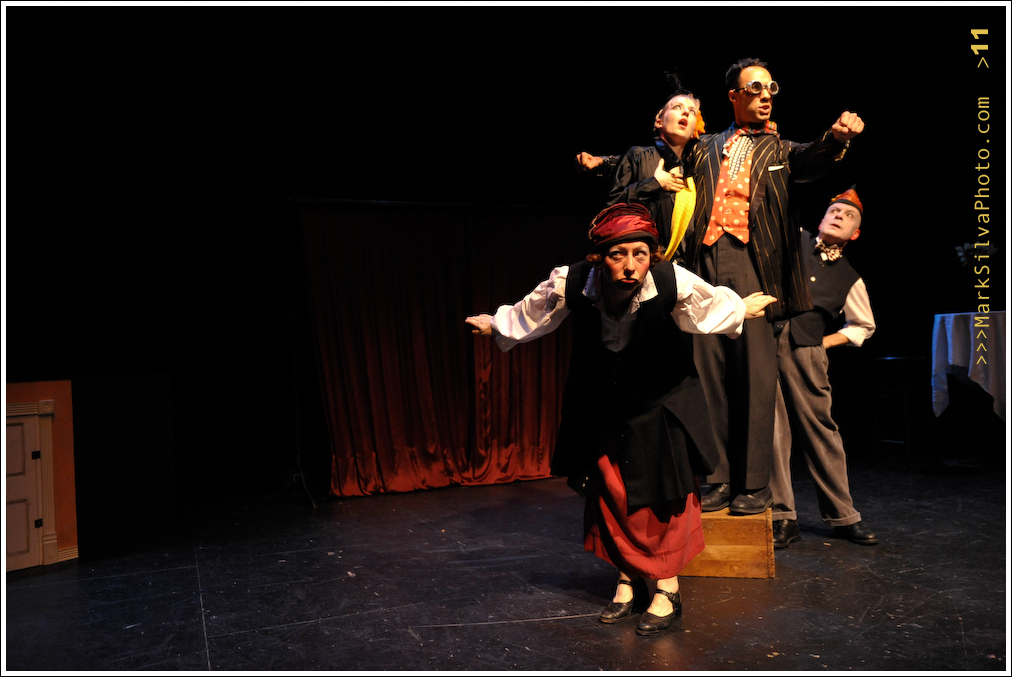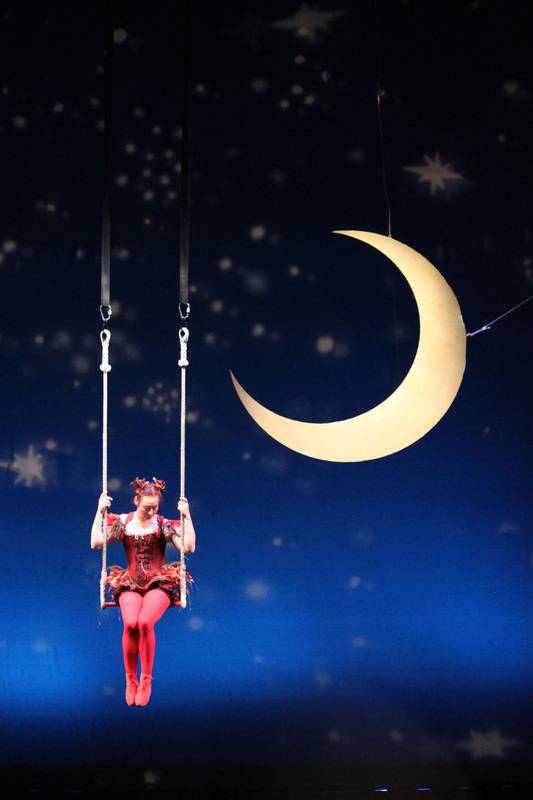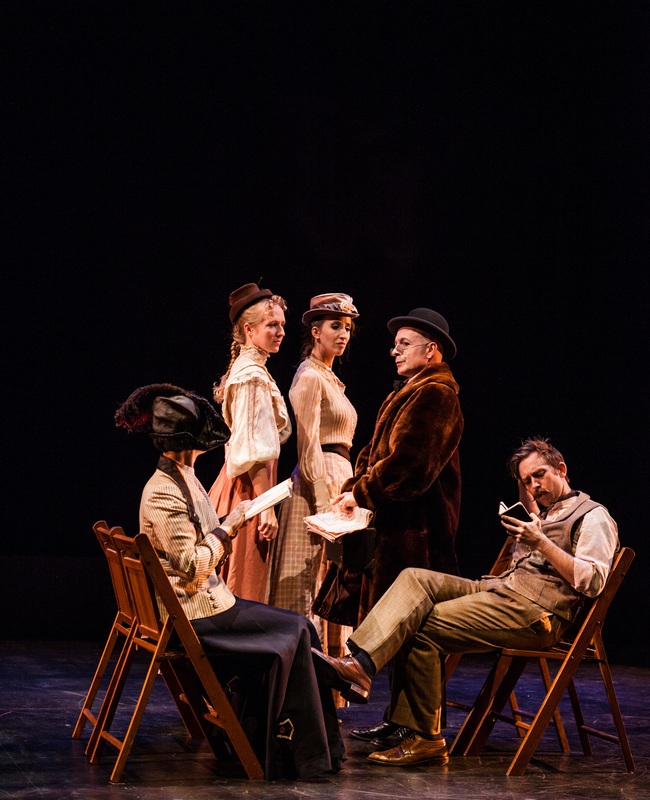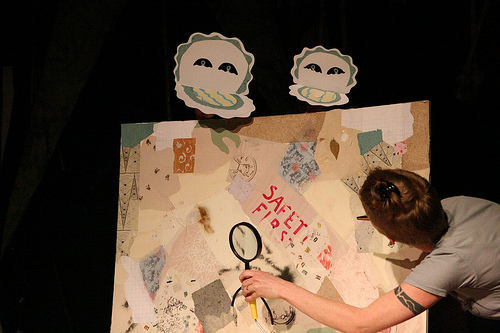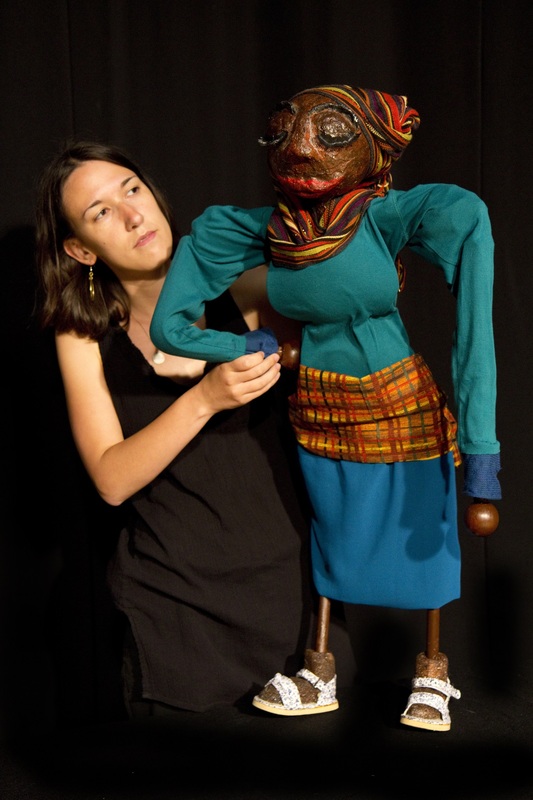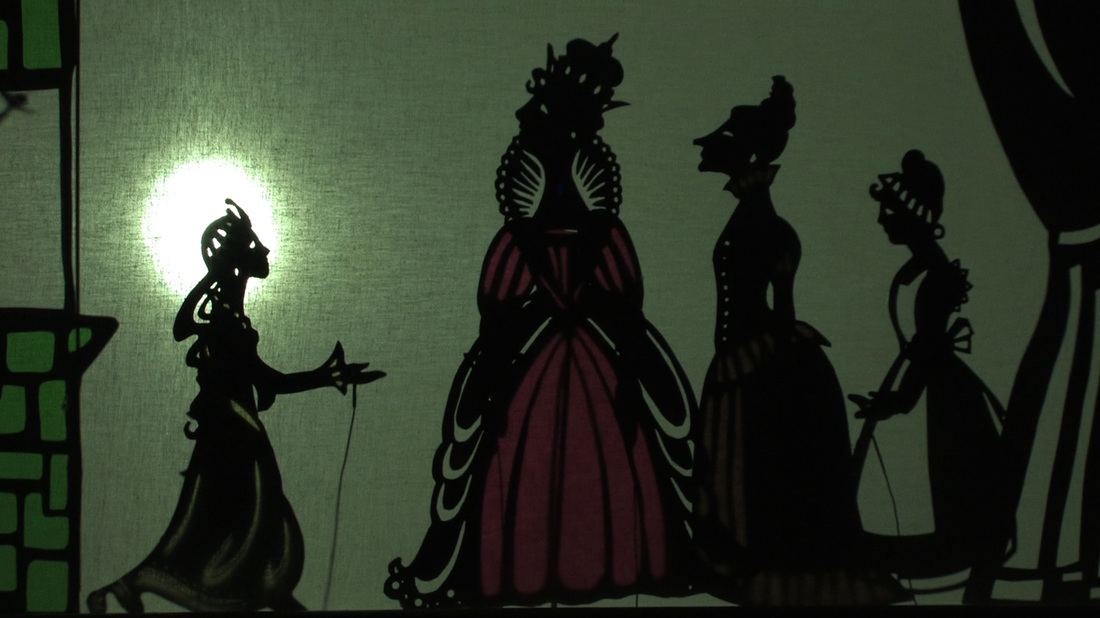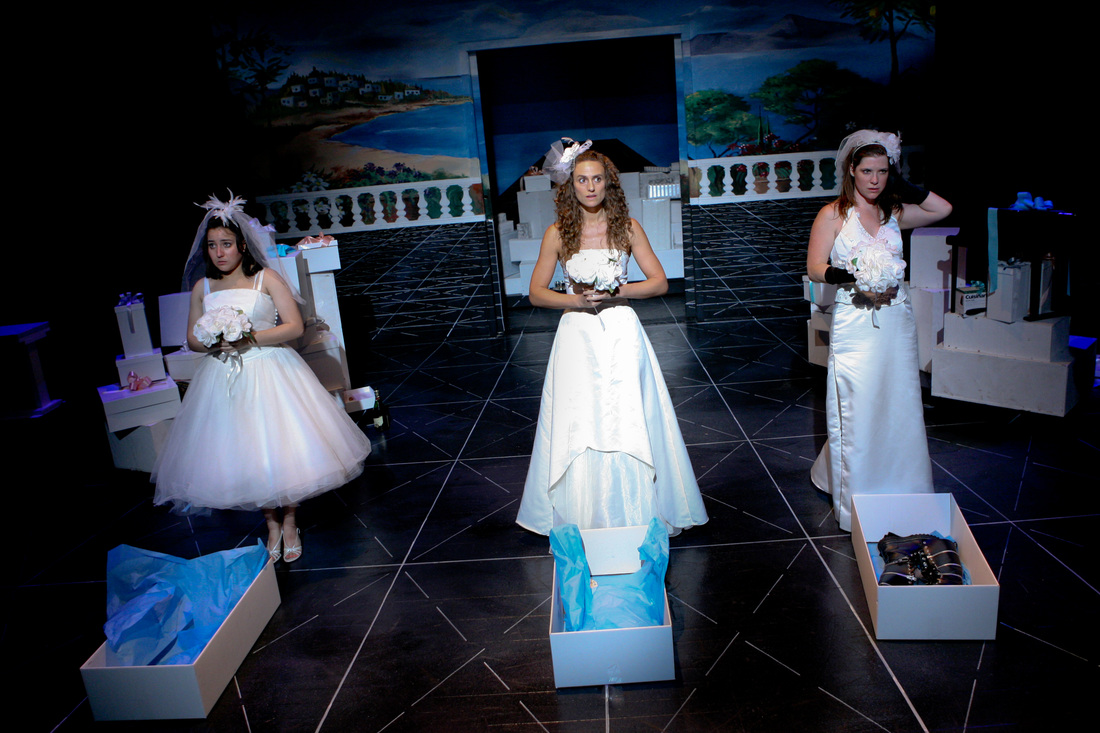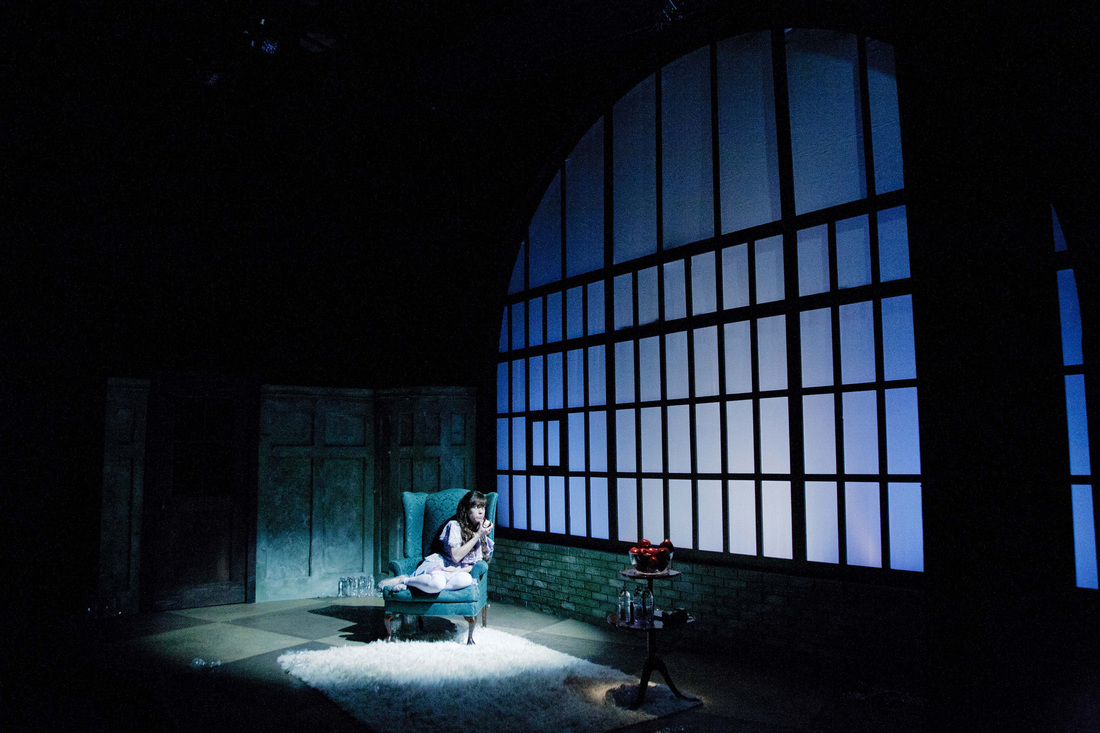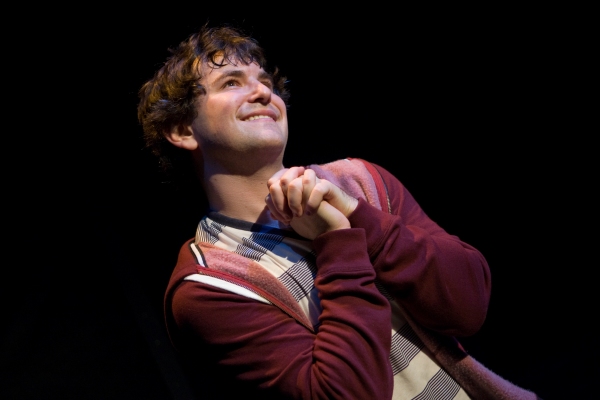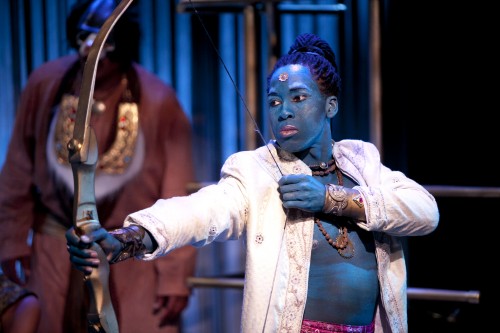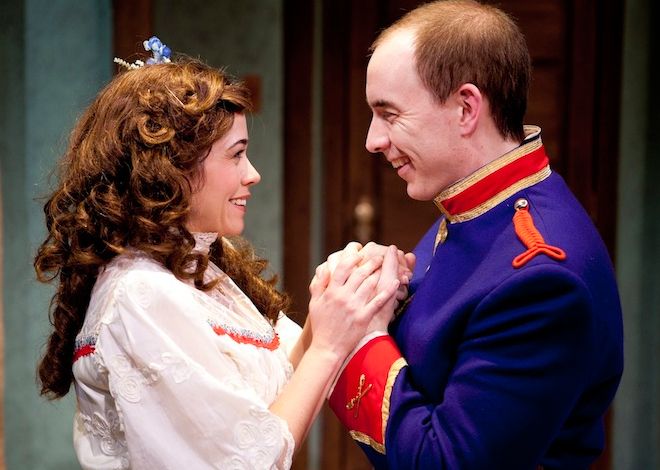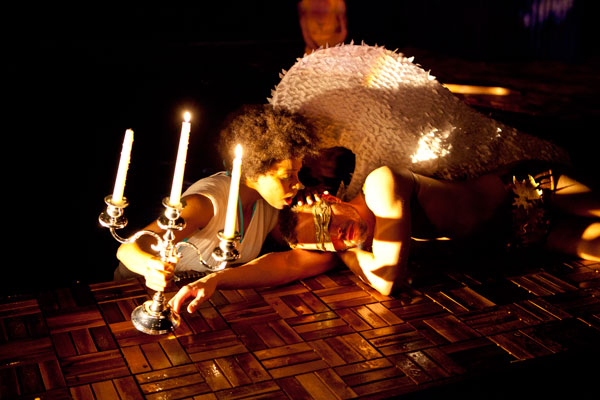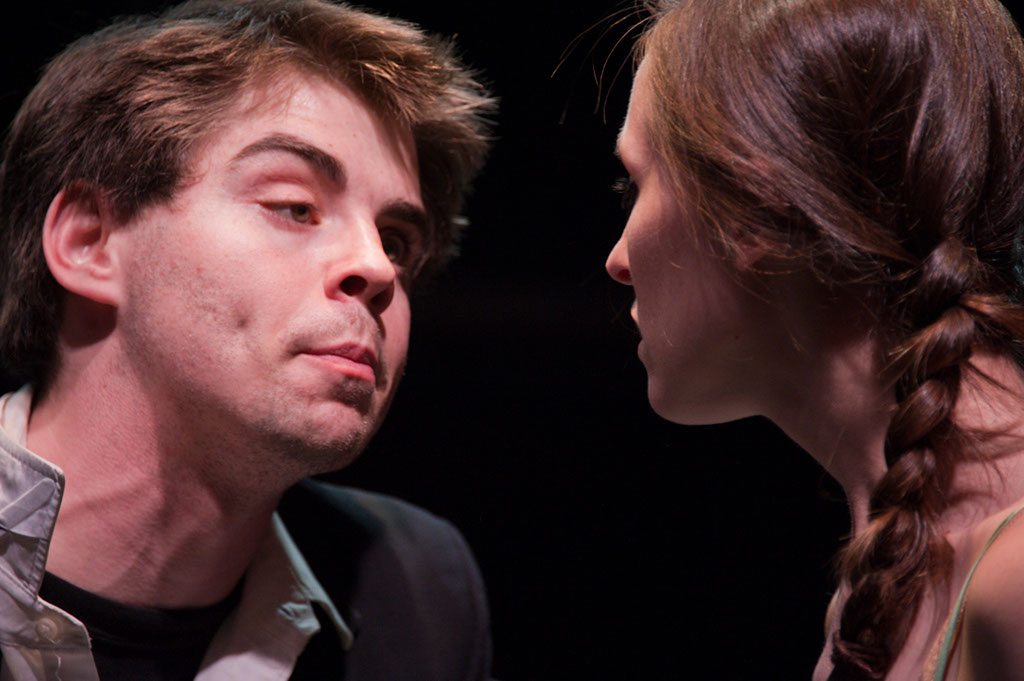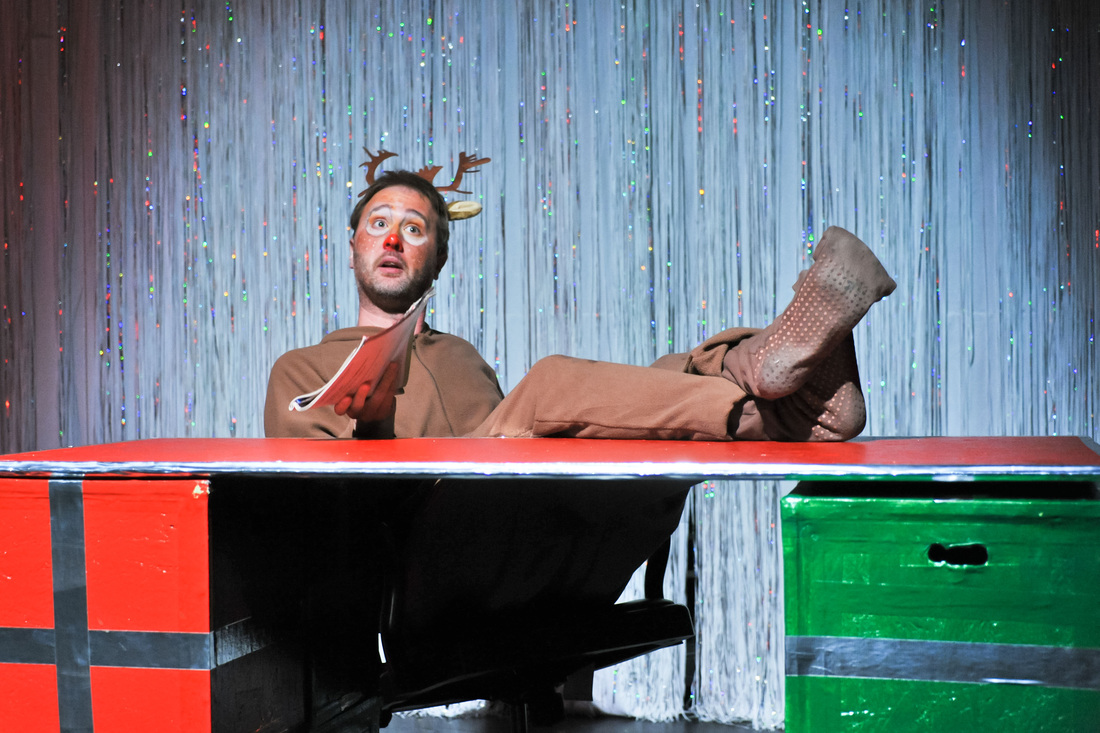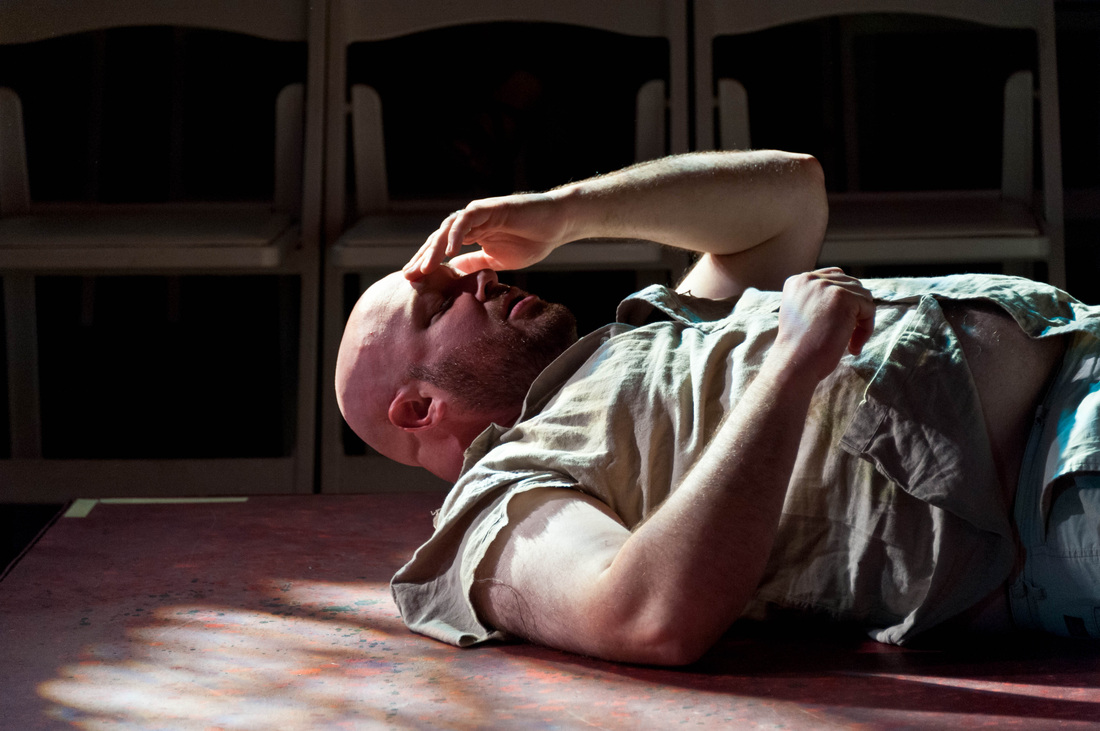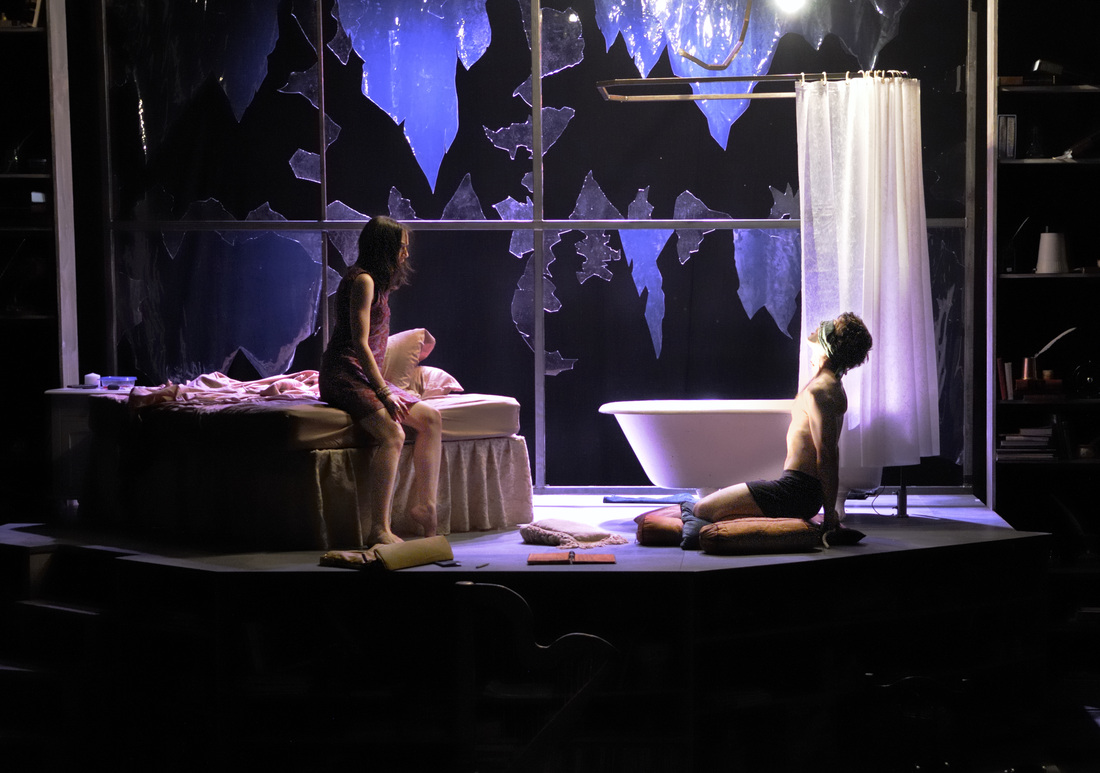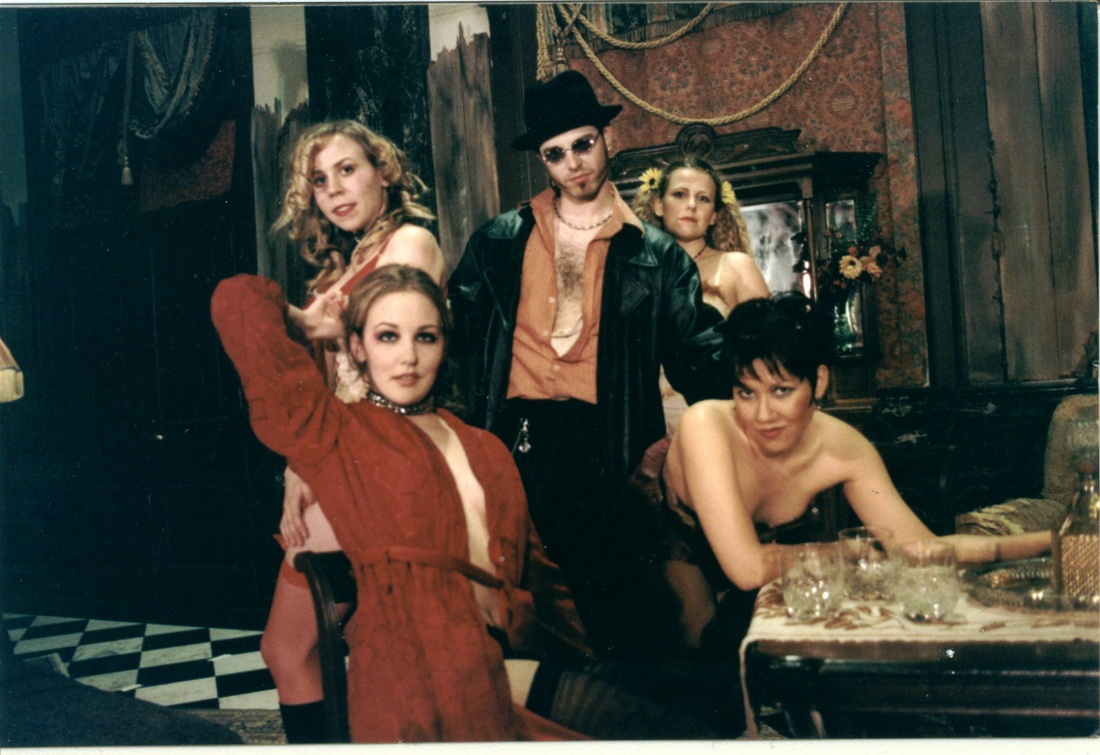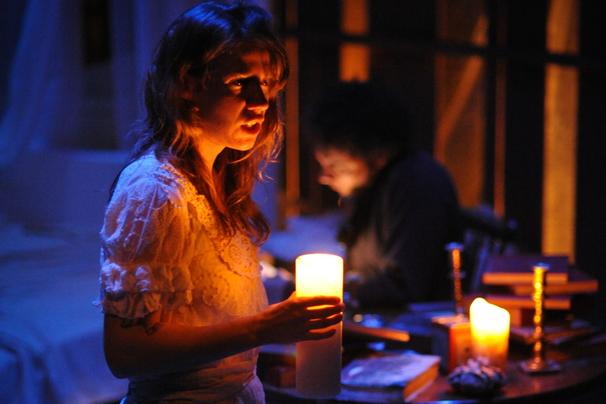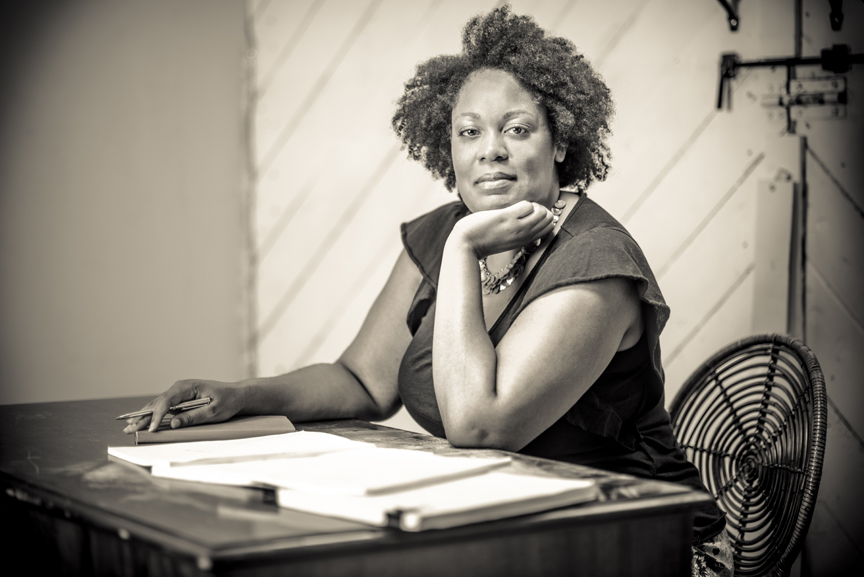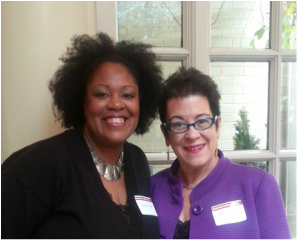 Each year, the Washingtonian publishes its list of 100 Most Powerful Women. This year’s list included 117 of the area's most influential women working in the arts, business, education, government, health, law, media, and nonprofit fields. The invitation asked that each honoree bring as their guest a woman with talent and tenacity whom the Washingtonian should watch in the future. The women were honored at a luncheon that was held in the beautiful Colonnade Room of the Fairmont Hotel in Georgetown. Click here to view photos from the event. The only reason I know about any of this is because on Monday morning Molly Smith, Artistic Director of Arena Stage, invited me to attend as her guest. I was honored, delighted, and quite simply floored. You could’ve knocked me over with a feather. As the leader of one of the preeminent regional theatres in the country, I have long admired Molly for her vision, ambition and passion. It was inspiring and empowering to spend time with her at this most prestigious event. Our Esteemed Host and Honored Guest SpeakerWashingtonian’s President and Publisher of Washingtonian Media Cathy Merrill Williams opened the event by sharing a powerful personal story. She and a group of close women friends were skiing in the Pacific Northwest on a mountain range along the border of Washington State and Canada. Cathy was sure to point out that she is a highly skilled and experienced skier. When she felt the snow moving beneath her, she knew immediately what was happening. She knew that she needed to pull the avalanche cord, a colored line that helps rescuers locate a skier if caught and buried in an avalanche. But she didn’t. She thought to herself, “I got this.” Moments later, she found herself covered in snow up to her neck. Thankfully, her friends and guide were there to help dig her out of the snow. She reminded us that in our day to day efforts and struggle for success, our ego can get in the way. Confidence can cloud hard experience, truth and knowledge. We should to do our best to check our ego at the door. When it does make its way through and we find ourselves trapped beneath 5 feet of snow, we should never to be too proud to accept the help of others who care about us. Then guest speaker Chris Simmons, Pricewaterhouse Coopers’ Managing Partner, took to the podium. He spoke to us quite candidly. He told us that if you’re married, an organization may feel entitled to pay you less money and that regardless of our achievements and accolades, men still run the world and they knew it. He reminded us that “Whoever people choose to have around them in their relaxed moments, those are who they will support and promote.” This is why he encourages women in power to “use your positions to make systemic changes within your organizations, but also to support other women. Each of you has the credibility to tell other women how extraordinary they are.” He believes in Gender Parity. He knows that you can’t have a solution to a problem when you exclude half the population. “There are good answers to problems that aren’t being addressed because women aren’t invited to the table.” He reminded us that while we all have our struggles, we can help each other. Lastly, he spoke about the merits of Lean In by Sheryl Sandberg. He appreciates that in her book, Sandberg asks women to choose partners, who will support and stand by us, and not get in the way of our success. He also like that she asks us to think about, “What would we do if we weren’t afraid?” He encouraged us to be fearless in our ambition, steadfast in our efforts and courageous in all that we do. It was a refreshing, enlightening and empowering speech. 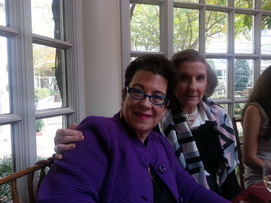 We dined on an absolutely delicious meal: a mixed green salad with some kind of new-age egg that was made of something that wasn't an egg at all followed by chicken for the meat eaters and spinach lasagna for the vegetarians. We were also served some rather fancy wine. This was quite the "Ladies who Lunch" affair! Seated at our table was none other than Wilhelmina Cole Holladay, founder and chairman, of the National Museum of Women in the Arts. At 91, she is sharp, convivial, and lovely. I couldn't help, but share that I had visited the gallery recently to take in the exhibit, American People, Black Light: Faith Ringgold’s Paintings of the 1960s. She smiled with such delight and told a few personal stories of her and Faith. Throughout the event, Molly introduced me to a number of nominees and we also sought out a few to meet together. And we talked. She spoke about the trajectory of her career, the personal and professional challenges that she's faced and overcome, and the impact she hopes to make on the D.C. community and the American Theatre. And as a true mentor, we spoke about my dreams and ambitions and about where I am in my life ... this exhilarating and frightening transition that is fraught with such potential and uncertainty. She was excited for me and gave me some much-needed encouragement and advice. 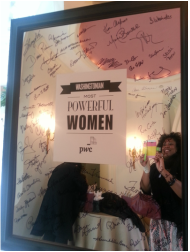 As the event came to a close, my heart swelled with such appreciation and I felt so fortunate to be in this room filled with so many accomplished women. I thought about how far I had come from my days as a poor Texas farm girl, who was filled with so many dreams for what my future could be. I am where I am today because of parents who believed in me and instilled in me a thirst for knowledge, and because of the many amazing mentors in my life. All of which have been women. I left the event feeling inspired and invigorated, and also more grounded and hopeful than I have in such a long time. Thank you, Molly, for your time, support and enthusiasm. Thank you Washingtonian and PWC for celebrating the hard work and achievements of women in the Washington area. Click here for a full list of the nominees and see below to learn more about the Arts and Letters nominees. Arts and Letters Honoree BiosMarin Alsop, musical director, Baltimore Symphony Orchestra. Alsop is the maestra with the mostest at the Music Center at Strathmore, where the BSO plays a third of its concerts. Jenny Bilfield, president and CEO, Washington Performing Arts Society. Bilfield is the area's major performing-arts producer, bringing artists of all genres to audiences in many venues. The first woman to head the WPAS, she came from Stanford in January with expectations to bring more contemporary artists to local stages. Elizabeth Broun, Johnnetta B. Cole, and Kim Sajet, directors, Smithsonian museums. Broun (American Art Museum), Cole (National Museum of African Art), and Sajet (National Portrait Gallery) run three of Washington's major museums, including laboratories in each where visitors can observe the conservation of invaluable works of art. Monica Jeffries Hazangeles, president, Strathmore. Hazangeles took over the arts center from Eliot Pfanstiehl (now CEO) in 2010, after serving as executive vice president and heading a $110-million campaign to raise funds for organizational development and a long-term endowment. Strathmore is bursting with artistic energy both in its education programs and on its stages. Wilhelmina Cole Holladay, founder and chairman, National Museum of Women in the Arts. The cultural visionary used her personal collection to create an institution that spotlights women's long-ignored artistic endeavors. Victoria Sant, president of the board, National Gallery of Art. A major philanthropic force in Washington, Sant has supported not only the National Gallery but also the Summit Foundation, the Smithsonian, and Vital Voices. Sky Sitney, director, AFI Docs. The documentary-film festival has grown to include 53 works shown in venues in Silver Spring and downtown DC, attracting thousands and offering opportunities for filmmakers to meet with policymakers. Molly Smith, artistic director, Arena Stage. The queen of DC's theater scene helped shepherd One Night With Janis Joplin—which had successful runs at Arena both last fall and this summer—to Broadway, where the Randy Johnson-directed production opened in October. Francesca Zambello, artistic director, Washington National Opera. Zambello took over from Plácido Domingo in 2012, cementing the WNO's merger with the Kennedy Center. She's also responsible for directing the Young Artist Program and commissioning new works. In her spare time, she directs one opera each season at the WNO and heads the Glimmerglass Festival in Cooperstown, New York.  The Washingtonian, the magazine Washington lives by, is the region's top source of information for dining, shopping, entertainment, and personalities. It has been Washington's most trusted guide to living, working, and playing in the area for more than four decades thanks to features like "100 Very Best Restaurants," "Top Doctors," and "Great Places to Live." The magazine is read each month by more than 400,000 people, who spend an average of 96 minutes with each issue and save each issue for an average of five months. The Washingtonian, under the guidance of its longtime editor, Jack Limpert, is a five-time National Magazine Award winner for its reporting and writing. Washingtonian.com, the online extension of the magazine, helps hundreds of thousands of residents and visitors explore and live in the nation's capital. From planning a night out on the town to locating the best pediatrician or lining up a new hairstylist, Washingtonian.com is the region's premier destination for lifestyle information. Through online chats with editors, online columns, events calendars, and blogs, the site helps readers keep up with everything happening around them. Whether you're contemplating moving and want to know the area's best places to live or contemplating switching jobs and want to know the region's best places to work, Washingtonian.com is the national capital region's one stop for trustworthy, dependable, and thoughtful advice
0 Comments
JACQUELINE LAWTON: Why did you decide to get into theatre? Was there someone or a particular show that inspired you?
SHIRLEY SEROTSKY: I’ll speak in terms of artistic leadership for this one. The concept of an artistic director was one that I first came to understand in college. As a directing student at the North Carolina School of the Arts we had the opportunity to do at least one Assistant Directing gig away from school, my year they sent us to Atlanta to assist on a production at the Alliance Theatre. There we met with ADs, directors, and other theater artists in town—including, of course, the Artistic Director of the Alliance at the time, Kenny Leon. I remember him talking about his first years as AD of this major institution, helming what was seen as a radical overhaul—which transformed the theater from a safe regional theater catering mostly to white suburban audiences to a much more dynamic, risky, and culturally diverse theater. He reflected that while these changes alienated some audiences (indeed, subscription numbers dropped noticeably) changes were necessary to achieve a stronger future vision for the company. So, his leadership very much put Alliance on the map as a theater to reckon with, and yet others saw the change as a failure, because subscriber numbers waned. This conversation really opened my eyes to the challenges an artistic leader faces. How do we balance priorities? How do we challenge audiences without alienating them? When must we let patrons go? What is growth and what is stagnation—artistically, financially, and in terms of infrastructure? And why does growth in one of these areas sometimes hinder the growth of another? This was an early, eye-opening conversation about season planning and artistic mission for me, one that—fourteen years later--I still think about. JL: How long have you served as Associate Artistic Director at Theater J both in terms of title and in duties and responsibilities? What drew you to working at Theater J? What keeps you there? SS: I became AAD at Theater J in December 2012, after four and a half years as the Director of Literary and Public Programs. I wrote a letter to Ari Roth in 2005 telling him of my interest in new plays and my admiration for the work Theater J was doing in that arena. A year later he saw my production of TWO ROOMS at Theatre Alliance, and I believe then we corresponded about viewing the Middle East through the lens of theater. I’d visited Israel in 1999, and was blissfully unaware at the time that I was travelling during a rare and precious moment of relative peace. As I caught up on reading about the region while working on that play, I also became aware of the Voices from a Changing Middle East festival at Theater J. I was a child of the 1980s and remember pretty vividly the final years of cold war fear. Around the turn of the 2000s it hit me that this would be the fear we would live with for the next generation, perhaps for the rest of my life—the uncertainty and trepidation that comes with the conflicts in the middle east and the rise of religious extremism in locations around the world. It seemed to me at the time that doing theater that looks at these big questions of faith, geopolitics, and humanity—in a way that is not boring or didactic --is the most important thing we could be doing as artists. I still feel that way. JL: What is the most valuable lesson you learned so far? Also, what traits do you feel a successful Artistic or Associate Artistic Director should have to support the health and growth of an organization? SS: The thing that continues to blow my mind about being an artistic leader is how many different groups of people one has to consider. Sure, directing requires great collaboration, and guiding a vision while communicating with actors, designers and the producing theater is a challenge. But add to that a board, marketing and development teams, regular patrons and friends of the theater, and any partner organizations or departments, and this becomes a sometimes daunting venture requiring good listening, even better communicating, awesome flexibility, lots of meaningful gut checks, and an amazing amount of patience. JL: What excites you most about being an Associate Artistic Director? What do you feel your greatest challenges will be? SS: See above. It can be a comfort to retreat into an artistic bubble and not have to worry about budgets or grants or future planning. But the more I am involved with the big-picture conversations here at Theater J, the more I learn and the more I am challenged. These are both great things. And because of the global focus of the work we do here at the J, I find myself constantly realizing that I need to LEARN MORE. About history, about art, about music, about the Middle East, about the Sudan, about the 1970s, about theology, about the Civil War, about Jim Crow, about Sarajevo, about superheroes, about philosophy…and the list goes on. And I love this. JL: Does your work as an Associate Artistic director pay the bills? If not, what else did you do? How do you balance your role leading an organization with your work as a director? Are you ever able to direct outside of your company? SS: It does pay the bills. I also add some freelance directing and teaching into the mix. And yes, I am able to direct outside of Theater J, and find that when I hit the balance right the my work at the J cross-pollinates the work I do elsewhere in gratifying and meaningful ways. JL: Looking at your body of work as an Associate Artistic director and a director in the community, how conscious were you of selecting plays by women or people of color when deciding your season? Also, when it comes to hiring administrators, designers and other directors do you take race and gender into consideration? SS: Very conscious, but in a way that isn’t necessarily about meeting quotas or percentages. It’s something more innate than that for me. Eight of the eleven of us here at TJ are women, so the female voice within the room is very strong. Our board is primarily women, the CEO of the DCJCC of which we are the resident theater company is a woman, I think if we ever pitched a season of all male playwrights or directors it would show an odd and unfathomable disconnect. Our representation of artists of color is trickier because we are a culturally specific theater and there’s tended to be a specific idea of what some who is Jewish looks like, or what entails a “Jewish-themed” play. I have watched that idea expand and swell in the time I’ve been here, and I’m glad. JL: DC audiences are . . . SS: Not afraid to tell you what they think. JL: DC actors and designers are . . . SS: My best friends and collaborators. JL: DC playwrights are … SS: Storming the castles, in wonderful and important ways. JL: DC critics are . . . SS: Part of the bigger conversation. JL: What advice do you have for an up and coming theatre artists who have just moved to D.C.? SS: SS: See above! Take advantage of the opportunities that this community offers you. Meet like-minded artists that you want to work with, find a community, an artistic family. Hone in on what you, specifically, bring to this art form and know why you do it. Assistant Direct for people whose work you respect and admire—recognize what you like about how they work, and also what you would do differently. Reach out to artists you respect in the community, at all levels. Invite them out to coffee to ask them about what they do and how they do it. More often than not, they’ll say “yes”. Read, see, talk, share. Care about things other than the theater. And I’ll quote the advice that Kathy Bates, the commencement speaker at my graduation from an arts conservatory shared with us: “Get a life”. As in, a life beyond the theater. Care about the world, your friends, your family; find ways other than your work to feed your soul. JL: What's next for you as a director and your company? SS: I start rehearsals for A Man, His Wife, and His Hat by Lauren Yee at the Hub Theatre in March. And Theater J starts previews for David Mamet’s Race of February 6. We’re also holding a center-wide symposium on race that should provide a forum for some challenging conversations over President’s Day weekend, February 16-17. JACQUELINE LAWTON: Why did you decide to get into theatre? Was there someone or a particular show that inspired you?
MARY HALL SURFACE: I actually have a moment I can pinpoint. I was a sophomore in college, studying theatre in London. I was standing on a landing in a Victorian Toy Theatre Museum, looking out into the street through a beveled glass window (what I still like to do best when in a museum or historic building, look out through their windows at the world.) I’d been wrestling with what do to with my love of all the performing arts, literature, cultural history, visual art and my overwhelming 20-year old desire to “do something” for the world. Perhaps its was the prism of perspectives offered by the window of the lively street below of a city I adored and the exquisite little worlds crafted by the toy theatre makers all rolled up into one, but I remember stopping in my tracks and saying, “I got it. I’ll be an artist who makes worlds on stage and off. I’ll make them about questions and connection, and make them deeply beautiful.” Been working on that one ever since. JL: How long have you served as Artistic Director at your company? What drew you to the position? What keeps you there? MHS: INTERSECTIONS began in 2010 as a project of the Atlas Performing Arts center to provide a prism (imagine that!) of perspectives through the arts on our lives as a richly diverse community. I was tapped to put it all together, having directed the play that opened the Atlas (Coming Home by David Emerson Tony) and then having stayed connected to Atlas, and believing deeply in its potential. The opportunity to help “make a world” on the Atlas stages and, just as importantly, in its meeting places that is inclusive, inquisitive, hopeful as well as challenging and perspective broadening, is why I signed on. The continuing potential of what we are trying to do keeps me there. JL: What is the most valuable lesson you learned during your tenure? Also, what skills and traits do you feel a successful artistic director should have to support the health and growth of an organization? MHS: Be open the evolution of what you are creating. Missions expand, refine in concert with changes in the community, the culture. Listen more than talk. Create an environment in which everyone has a stake, a claim, an investment. Ensure that everyone in the organization can do their best work by supporting them, challenging them, believing in them. Operate out of a sense of possibility. JL: What excites you most about being an Artistic Director? What is your greatest challenge? MHS: I love the growing intersection of art forms and the collaborations that are being born from artists meeting at the festival. This fulfills one of our central goals– to connect artists across disciplines as well as age, culture and community. At the November artist “kick-off” party, there was a palatable excitement among artists meeting for the first time, discovering potential connections. I get the same feeling when I’m a part of the festival audience, where people who are normally not in the same room gather and have an experience in common. Greatest challenge: there are always the financial challenges of making it all happen. But equally, I want to deepen the dialogue with the community to ensure that the work is authentic and responsive. JL: If your work as an artistic director doesn’t pay the bills, what else do you do? Also, how do you balance your role leading an organization with your work as a director? Are you ever able to direct outside of your company? MHS: I see the festival, itself, as directing one giant multi-scene production, in a way. And I work as a playwright, director and teaching artist in addition to my work as the AD of INTERSECTIONS. I am able to do one to three other directing/writing projects per season in addition to the festival (I just completed a multi-disciplinary performance for the National Gallery of Art, FRAMED!, to complement their Roy Lichtenstein exhibit.) This year, for the first time, I am directing a play for family audiences that will perform at the festival. This might signal my demise. We shall see J. JL: Looking at your body of work as an artistic director and a director, how conscious are you and selecting plays by women or people of color when deciding your season? Also, when it comes to hiring administrators, designers and other directors do you take race and gender into consideration? MHS: The Atlas has a long-standing commitment to diversity in its staff and board. The entire ethos of INTERSECTIONS is built on ensuring that all voices are heard. So we are all about projects created by artists of color and women are in full force as directors, choreographers, composers, and creators. JL: DC audiences are ... MHS: Willing to be adventurous when they come to INTERSECTIONS, which is thrilling, as that’s the point. JL: DC actors and designers are ... MHS: Inventive and generous in their work with INTERSECTIONS. JL: DC playwrights are … MHS: Being showcased at the Festival for a second year in a piece called, 360º of America: Force Majeure. Playwrights include Katherine Akerley, Bob Bartlett, Mary Stone Hanley, Kristen LePine, Danielle Mohlman, Malcolm Pelles, Anu Yadav and Laura Zam. JL: DC critics are ... MHS: Part of the team, ideally. JL: What advice do you have for an up and coming theatre artists who have just moved to D.C.? MHS: See as much work as you can. Be open-minded. Support each other. Take advantage of all that is here (free museums, world-class libraries, remarkable nature close at hand.) JL: What's next for you as a director and your company? MHS: INTERSECTION opens on Feb 22. Between now and then, I am working to help develop a number of the world premieres that will happen at the festival and to build partnerships within the community to engage audiences as fully as possible in the festival. I’m also directing my musical (written with my long time collaborator, composer David Maddox) Sing Down the Moon with the most excellent students of Catholic University’s musical theatre program, to be produced at INTERSECTIONS. www.intersectionsdc.org says it all. JACQUELINE LAWTON: Why did you decide to get into theatre? Was there someone or a particular show that inspired you?
CATHERIINE ASELFORD: I grew up around theatre. My father was a theatre musician – house band at the National, played all the shows at Ford’s, rehearsal piano for opera and ballet, etc. I wasn’t too interested in musicals – I guess because I was so familiar with them, they held no glamour for me. When I read Macbeth, I decided I wanted to be an actor. Later, at Catholic U, I read The Revengers’ Tragedy and decided I wanted to direct. I switched to the Directing Program. Back in the ‘80’s, directors often pitched scripts to theatres – far more than they do today – and I was seduced into directing by literature I loved. JL: How long have you served as Artistic Director at your company? What drew you to the position? What keeps you there? CA: I was one of the four founders of The Georgetown Theatre Company. After the original Artistic Director moved to NYC to direct operas, I took on the position in 1993. I was reluctant, because I didn’t want to become an administrator. JL: What is the most valuable lesson you learned during your tenure? CA: Success follows money; money doesn't’ follow success. JL: What excites you most about being an Artistic Director? What is your greatest challenge? CA: Creating programs – whether a production, a reading series, or a collaborative performance event – excites me. Creating good work is also a challenge, because everything has to go right—one thing going wrong can ruin a project. As an Artistic Director, I get the opportunity to turn my ideas into programs, and the challenge of making the programs happen. JL: If your work as an artistic director doesn’t pay the bills, what else do you do? Also, how do you balance your role leading an organization with your work as a director? Are you ever able to direct outside of your company? CA: I never supported myself as a director. For a short time, I supported myself as an actor, then as a theatre teacher (I went back to school to get my Maryland teaching certification). I’m now Executive Director of the Northern Virginia Fine Arts Association, an arts center in Old Town Alexandria. I think it’s important to direct outside one’s own company. Otherwise, a director risks cutting herself off from so many influences. JL: Looking at your body of work as an artistic director and a director, how conscious are you and selecting plays by women or people of color when deciding your season? Also, when it comes to hiring administrators, designers and other directors do you take race and gender into consideration? CA: When we founded TGTC (now Guillotine Theatre), only the Folger Shakespeare Theatre was presenting classics, so our goal was to present classic plays by other authors. Because of that early mission, we chose mostly shows by dead white men. In 1993, we opened the mission up to include adaptations of classic literature, and since then we’ve produced lots more plays by women. One of my favorite novelists of color, Alexandre Dumas, is adapted to play form all the time (he was also a playwright himself); we presented two adaptations of his works, both by women playwrights. When it comes to hiring other artists – performers, directors, or designers – I’m colorblind. Some directors deliberately cast actors of colors in certain roles in order to make a point. I focus on what the actor – aside from skin color -- can bring to the role. Of course, when working on plays that deal with race issues, the director needs to take race and ethnicity into consideration when casting. I don’t do too much cross gender-casting, but when I do it’s because there are so many talented women, and so few women’s roles in Renaissance through 18th century plays. JL: DC audiences are … CA: More intelligent than some producers, directors and playwrights realize. Come on, people, don’t be afraid of big words and big ideas. JL: DC actors and designers are … CA: Incredibly creative! JL: DC playwrights are .. CA: Increasingly part of a national community of writers, who are produced all over, not just in their home cities. JL: DC critics are … CA: Getting younger, and that’s good! Peter Marks is the best POST lead critic we’ve had since Richard Coe (I’m not sucking up, I just hated the last two critics), but more and more reviews are coming from the keyboards of people in their ‘30’s. These young reviewers tend to call out productions that skimp on basic storytelling, or that don’t hold the audience’s interest. JL: What advice do you have for an up and coming theatre artists who have just moved to D.C.? CA: If you’re an actor, audition for everything. If you’re a director or designer, volunteer a lot. JL: What's next for you as a director and your company? CA: DC SWAN (Support Women Artists Now) Day is next for us. It’s Saturday, March 23. DC SWAN Day features the Staged Reading Marathon, at the National Museum of Women in the Arts. The Marathon is 12-15 short plays by women playwrights from all over the USA (and sometimes abroad), directed by DC area women directors. This year, we are presenting a “best-of” selection of plays read in the 2008-2012 DC SWAN Days. Check us out at www.georgetowntheatre.org JACQUELINE LAWTON: Why did you decide to get into theatre? Was there someone or a particular show that inspired you?
SABRINA MANDELL: Theatre was always something I did from as far back as I can remember. My mother gave me a book about Sarah Bernhardt when I was 4 years old and I was convinced that it was about me, that I was her reincarnation. Then when I was about 9 years old I saw the film "The Dresser" starring Peter O'Toole and it resonated so deeply with me that I knew I would somehow become a stage actor. Then after much struggle finding a path to the kind of theatre I wanted to do - not interested in conventional, script-based work - I saw many shows over the years that inspired me, but I didn't know how to insert myself into them or where to begin then I stumbled on the pedagogy of Jacques Lecoq and landed on a passion for physical, devised theatre and started gathering the tools to do it. JL: How long have you served as Artistic Director at your company? What drew you to the position? What keeps you there? SM: I founded the company in 2006 and have been Artistic Co-Director since then. The vision of the company is very much in my heart. I stay because there is nowhere I would rather be, nothing better in the universe. I have basically arrived at my dream. Also, my partner/husband is my co-director, and our work is completely integrated into our life. There is no separation for us. We are living our art and so there is no need to go elsewhere. Sometimes I wish I had a personal assistant or business manager, but that's a different issue... JL: What is the most valuable lesson you learned during your tenure? SM: Being willing to relinquish control, but also knowing when to hold fast to an idea. I have learned that the best art comes from finessing the balance of collaboration and leadership. I have learned that trust is essential and so is discipline; I have learned that structure is as necessary as exploration and freedom. I have learned that making art is not about expression, but is about dialog. JL: What excites you most about being an Artistic Director? What is your greatest challenge? SM: I am most excited about the opportunity to realize visions, my own and those of the Company. My greatest challenge is also having to manage the business and production ends of things. JL: If your work as an artistic director doesn’t pay the bills, what else do you do? Also, how do you balance your role leading an organization with your work as a director? Are you ever able to direct outside of your company? SM: Managing Happenstance Theater is the bulk of what I do, it doesn't really pay the bills. My husband and I parse together a livelihood out of freelance performance and collaborations, teaching, consultation, school shows, working as clowns with the Big Apple Circus Clown Care unit, corporate gigs, and being presented by established theatres. I don't know how I balance everything. I guess I'm a bit of maniac/superhero and I try to build in time for Spa World. I am not really a conventional "director" so that's not something I seek out, but I love working with companies as a movement consultant or dramaturg. JL: Looking at your body of work as an artistic director and a director, how conscious are you and selecting plays by women or people of color when deciding your season? Also, when it comes to hiring administrators, designers and other directors do you take race and gender into consideration? SM: I don't "select plays" so those considerations don't arise in that way. We also seldom hire designers, directors and have yet to have an administrator, much to my chagrine. I am always conscious of integration and inclusion, this is america after all, but the truth is it is not a priority. We have built our small company over the years based on the work that we have created and the relationships that have developed over time with our collaborators. Our work is not "issue" based. The company is not diverse in outward color, but the palette is rich with eccentricity. There are 4 women and 2 men in the performance ensemble. We are of eastern and central european descent, I am a jew, one of the men is white, but with roots in Brazil, one of the women is gay. None of this was strategic. JL: DC audiences are … SM: Lovely and very receptive. Sometimes it feels like they are too willing to go along and I wonder if the status-quo-bar gets set too low. JL: DC actors and designers are … SM: Not challenged enough to push beyond convention. Not driven to high quality because we exist in such a "supportive" environment. JL: DC playwrights are .. SM: Inspiring. JL: DC critics are … SM: Incidental. JL: What advice do you have for an up and coming theatre artists who have just moved to D.C.? SM: Be patient. Take classes. Go see shows and court the companies doing the work you are interested in doing. JL: What's next for you as a director and your company? SM: We have a show in development and we start rehearsals this week. It is called VANITAS and will run at Round House Theatre Silver Spring from March 29 - April 14. Come look into our Cabinet of Curiosities and see how Happenstance handles the Age of Discovery. Featuring Mark Jaster, Sabrina Mandell, Karen Hansen, Gwen Grastorf, Sarah Olmsted Thomas and Alex Vernon. In this new Happenstance Theater work of art, three archetypal characters, The Queen, The Fool, and the Musician, and their shadows, the three fates, play with Time and manipulate objects to remind the viewer to consider Imagination as a vehicle to transcend life's inevitabilities. Vanitas still-life painting was a genre that flourished in the Netherlands in the early 17th century. These paintings depict collections of objects symbolic of the inevitability of death and the transience of earthly achievements and pleasures, (Bouquets of cut flowers, skulls, and timepieces) and remind the viewer to consider mortality and spiritual life. For more information visit us at http://www.HappenstanceTheater.com JACQUELINE LAWTON: Why did you decide to get into theatre? Was there someone or a particular show that inspired you?
CECILIA CACKLEY: I was lucky enough to go to a high school with a huge theater program--we did 8-10 shows a year, almost all directed by students. For me, theater was a natural extension of all the games of 'playing pretend' from when I was a kid. I went back and forth between theater and music education as my main career goals, but when I ended up at a college with a theater department but no music education major, that pretty much decided things for me. The experience that got me hooked on puppetry was a retrospective exhibit on Julie Taymor at the National Museum of Women in the Arts that I saw when I was in high school. It made my brain explode with all the storytelling possibilities of puppets. JL: How long have you served as Artistic Director at your company? What drew you to the position? What keeps you there? CC: I've been calling myself the Artistic Director for a couple of months now. The company itself came into being very slowly and then all at once this past fall as we really starting preparing for our first full-length show. Since I've been the person who organizes everything, I ended up with the title 'artistic director,' and I'm still getting used to it. I'm excited to get to collaborate with new and old friends and tell stories in exciting ways with puppets! JL: What is the most valuable lesson you learned during your tenure? Also, what skills and traits do you feel a successful artistic director should have to support the health and growth of an organization? CC: This lesson is something I was told by an author, but I think it applies to theater artists as well as writers. If someone tells you "No" it really means "Not yet." That has been very valuable--to remember to be patient but also have perseverance. I think artistic directors need to be good listeners, with open minds. I think they need to be willing to take risks. Being organized and able to manage a lot of stress is also really helpful. JL: What excites you most about being an Artistic Director? What is your greatest challenge? CC: I love having the opportunity to tell the stories that I want to tell, and collaborate with lots of different artists. I'm excited to get to share puppetry with as many people as possible, both children and adults. My greatest challenge is balancing the various projects within the company, which include school workshops, performances of old shows and creation of new shows. It's a lot to keep up with and can be overwhelming sometimes. JL: If your work as an artistic director doesn’t pay the bills, what else do you do? Also, how do you balance your role leading an organization with your work as a director? CC: I used to teach elementary school full-time, but I left that about nine months ago so I could do more work as a puppeteer. So far, teaching artist work, stage-managing and part-time work in a bookstore have been enough to pay the bills. I will do pretty much any kind of work as long as it has some combination of art, books and children. Balancing the artistic work with the work of running the organization is definitely a challenge. I try to schedule specific times to work on business things and specific times to work on building puppets or sketching ideas. Genna Davidson and Pat Germann, who are my main collaborators, help me stay organized, and I've been lucky enough to have the opportunity to continue working as a director or performer with other companies as well. JL: Looking at your body of work as an artistic director and a director, how conscious are you and selecting plays by women or people of color when deciding your season? Also, when it comes to hiring administrators, designers and other directors do you take race and gender into consideration? CC: It's hard to say, since our body of work is still so small and almost all of it was created by me. But several of the sources for stories that I've turned into puppet shows are by women and I'm very interested in stories from different places around the world, especially Africa and Latin America. My hope is that our repertory will be diverse and so will our collaborators. I guess time will tell. JL: DC audiences are ... CC: Enthusiastic and diverse. JL: DC actors and designers are ... CC: Some of my favorite people in the world. JL: DC playwrights are … CC: Imaginative and out-of-the box thinkers. JL: DC critics are ... CC: People who have their own artistic tastes, just like any other audience member. JL: What advice do you have for an up and coming theatre artists who have just moved to D.C.? CC: Reach out to companies who are doing work that you love and ask if you can be involved in some way! Everyone is always eager to work with new people who share their enthusiasm for the arts. JL: What's next for you as a director and your company? CC: As a director I'll be working with Young Playwright's Theater in February on a staged reading in their New Writer's Now series. I'll also be continuing to build puppets for Wit's End Puppets' first full-length show The Amazing and Marvelous Cabinets of Kismet which will run at the Mead Theater Lab at Flashpoint April 26-May 19. It's an original story of one puppet's journey through fear and the unknown, and it uses a combination of puppets made from found objects and paper. I will be performing, and Carmen Wong is directing; we're all really excited to share it with DC audiences! JACQUELINE LAWTON: Why did you decide to get into theatre? Was there someone or a particular show that inspired you?
HELEN PAFUMI: I only briefly considered going into anything else. I discovered the stage early and because it was always a part of my life, it would have been more surprising if I had chosen something other than theatre. I briefly thought about politics, and painting. Both are still part of my life, but I am glad I chose to follow my current path. JL: How long have you served as Artistic Director at your company? What drew you to the position? What keeps you there? HP: I co-founded The Hub Theatre with two other amazing individuals – Marey Oakes and Maggie Ulmer – back in 2008. I have served as AD since our inception. Of the three of us, I was the natural producer. Maggie has a theatrical education background and Marey came from the administrative side of non-profits. We were a great trio. As the company changed, so did our lives. Marey serves on the Board and Maggie is in our company of artists. They are still my great sounding boards. I started The Hub in Fairfax because I felt that proximity to the city should not be the main factor in whether or not a community had high level, professional theatre. I am excited that Fairfax is growing in that realm with other professional organizations cropping up. I am driven to keep going by the fact that we are providing a new level of artistic service to this community. As urban sprawl continues, so does my belief that the future of theatre needs to lie in not just our urban centers, but in our outlying communities as well. I am very passionate about helping to define what that is, and will be. There are amazing artists and audiences in Fairfax County. Being in service to my community keeps me from ever thinking to narrowly about the plays I produce or the theatre in general. JL: What is the most valuable lesson you learned during your tenure? Also, what skills and traits do you feel a successful artistic director should have to support the health and growth of an organization? HP: The most valuable lesson I have learned is that the best idea in the room is what should be used. I have always known this logically, but it is a difficult practice to actuate. Respect cannot be sacrificed for it. The best collaborative artistic teams, board members, and staff all know this. They are able to lead with clarity and command respect, while still leaving room for the best idea from any corner. As for traits – I respect anyone coming through our doors, from those we work with to those who buy a ticket. I believe in a high level of collaboration, organization as well as artistry, an eye for great talent regardless of resume, a strong understanding of budgeting, strength of vision, adaptability, strategic thinking, and a passion for the mission of the company. That’s a run on sentence, and there are still more to go. JL What excites you most about being an Artistic Director? What is your greatest challenge? HP: I am most excited about sharing great work. When you get a stellar artistic team together with the right cast, working on the right play… the effect is what makes theatre magical. Buoying great artists and creating artistic collaborations is very rewarding. But the best moment is sitting at the back of the house, watching the audience take in everything we have collectively created. The greatest challenge is in making that magic without letting the gears show. Lack of money, time, staff, and equipment are the realities that can threaten an otherwise outstanding artistic product. It takes some major sleight of hand, and a great deal of help, for each production. JL: If your work as an artistic director doesn’t pay the bills, what else do you do? Also, how do you balance your role leading an organization with your work as a director? Are you ever able to direct outside of your company? HP: The Hub is my full time job now. Part time work includes acting from time to time, as well as dialect, audition, and public speaking coaching. I also teach creative drama to kids. I have not tried directing a full production outside of The Hub. I am sure I would if the time and play were right. As an actor though, I now will only take work outside The Hub. After the last show I did with my company I realized the burn out that would happen if I tried to produce and act at The Hub regularly. Being on stage in a Hub show cuts off my ability to take in our product as a producer or an audience member, and it is far more important for me to do that. And luckily, this area is graced with plenty of talent who are more than happy to take those roles. JL: Looking at your body of work as an artistic director and a director, how conscious are you and selecting plays by women or people of color when deciding your season? Also, when it comes to hiring administrators, designers and other directors do you take race and gender into consideration? HP: I give very little conscious thought to gender or ethnicity when I do my hiring. I bring on the best people and slate the best plays for a season. So far it has been very equitable when it comes to staffing. As for plays, although I have a good track record with gender equity, the same cannot be said of color. To be fair though, the last three plays by people of color that I asked for the rights to, were denied to The Hub. Still, its something I am aware of and am actively looking to address. JL: DC audiences are ... HP: Fun to watch a show with. JL: DC actors and designers are ... HP: Folks I am lucky to know and work with. JL: DC playwrights are .. HP: A force to be reckoned with. JL: DC critics are ... HP: Doing their jobs. JL: What advice do you have for an up and coming theatre artists who have just moved to D.C.? HP: Go to the theatre, intern (The Hub’s always looking!) get involved with the Source Festival, Fringe, attend open calls. Just get yourself out there. JL: What's next for you as a director and your company?? HP: I just directed HOW I PAID FOR COLLEGE by Marc Acito at The Hub. I am incredibly proud of the work that went into developing and producing that production. Next up I am producing A MAN, HIS WIFE, AND HIS HAT by Lauren Yee, at The Hub, which has just started preproduction. Find out more at www.thehubtheatre.org Jacqueline Lawton: Why did you decide to get into theatre? Was there someone or a particular show that inspired you?
Allison Stockman: I was in a community theatre production of Snow White in first grade and I was immediately hooked. Since then there has never been a year without at least one show, if not five. I love the live community experience and I love being part of a collaborative art form. JL: How long have you served as Artistic Director at your company? What drew you to the position? What keeps you there? AS: I have been the Artistic Director of Constellation Theatre Company since founding it in 2007, six years ago. Throughout my life I’ve been drawn to leadership roles and to the theatre so being an Artistic Director is a great fit. I started Constellation because I wanted to direct epic, ensemble plays that emphasize the interdisciplinary nature of theatre – uniting elevated language, visual spectacle, original music and heightened movement. I wanted to develop a community of artists that love to work together and it often feels like a family. JL: What is the most valuable lesson you learned during your tenure? Also, what skills and traits do you feel a successful artistic director should have to support the health and growth of an organization? AS: I am learning new lessons everyday. Currently I am focusing on strategic planning and trying to imagine the future of the company in one year, in five years. A successful artistic director has to have a passion for the mission of the company. They should value and respect everyone associated with the organization, from artists to technicians, from donors to ushers. It’s a challenge, but I always try to remember that it has to be fun. No one is getting paid enough for it to be anything else. Don’t be shy to ask for money – you’re giving people an opportunity to be involved. (She says to herself, looking into the mirror;) JL: What excites you most about being an Artistic Director? AS: I love fostering good matches between directors, actors, designers, other artists etc. I love to think about how we can best serve the play in a way that is imaginative and exciting. JL: What is the greatest challenge you faced being an Artistic Director? AS: My greatest challenge is season selection. Deciding what plays to do is so important and there are so many aspects to consider: Does it fit the mission? Can we achieve success with this play in our space, on our budget? How does one play balance with others in the season? Will we be able to draw an audience? JL: If your work as an artistic director doesn’t pay the bills, what else do you do? Also, how do you balance your role leading an organization with your work as a director? Are you ever able to direct outside of your company? AS: Since I started Constellation I’ve been able to direct workshops, readings, gala performances, but I haven’t been able to commit to a full rehearsal process. Now, I finally feel like I would be able to direct elsewhere and Constellation would be able to continue our schedule without my being around quite as much. I would love the opportunity to direct at another theatre in the near future. Constellation benefits from every guest director that we bring in; I would love to be in the creative process at a different theatre and see how their practices differ from ours. JL: Looking at your body of work as an artistic director and a director, how conscious are you and selecting plays by women or people of color when deciding your season? Also, when it comes to hiring administrators, designers and other directors do you take race and gender into consideration? AS: Constellation tells stories from all over the world so there is an internationally diverse aspect to what we do. We strive to do plays that reveal the vast range of the human experience and so we embrace different perspectives. It’s exciting to collaborate with all kinds of people, diverse in race, age, culture, sexual orientation, religion, experience, etc. Of the three guest directors Constellation has had so far, two are women. This is great, but not particularly by design. I love their work. JL: DC audiences are ... AS: ... curious, enthusiastic, well-educated JL: DC actors and designers are ... AS: ... dedicated, inspired, friendly JL: DC playwrights are … AS: … imaginative, brave, inventive JL: DC critics are ... AS: … unpredictable JL: What advice do you have for an up and coming theatre artists who have just moved to D.C.? AS: Get to know as many people as possible. Accept any opportunity to practice your craft that isn’t morally objectionable. Take the initiative to create art on a small scale. Investigate the Fringe. JL: What's next for you as a director and your company?? AS: We’re opening Zorro next week. It’s our first world premiere and I’m incredibly excited. While that swashbuckling adventure entertains DC audiences, we will be designing one of the oldest stories in the world, the epic Gilgamesh. JACQUELINE LAWTON: Why did you decide to get into theatre? Was there someone or a particular show that inspired you?
CHRISTINE LANGE: I'm not sure it was really a decision. I had a certain aptitude for creating my own world and telling other people what to do (some might say I was bossy) that lent itself naturally to theater. My first play was in the 2nd grade, but I didn't take theater classes until 7th grade. And even then, I never considered it as a potential career or something I'd devote my life to - it was just fun. My freshman year in college, I had plotted out my course as a biology-geology double major with appropriate internships, and eventual PhD in Marine Biology. A friend directed a short play I wrote as part of a cabaret at her college, and I went to see it. I was struck by the realization that these people were in this room because I had written a play. Something I put into motion as an individual drew all these people together to this one place. Whether it was writing, acting, or directing, whatever came out of it was unique to me, and I suddenly understood how much I craved that. It didn't matter if my version was better or worse (although you always want it to be better) than someone else's - it mattered that only I could do my version of it. So I transferred to George Mason and got my degree in Theater. JL: How long have you served as Artistic Director at your company? What drew you to the position? What keeps you there? CL: Grain of Sand is about 2 years old since it began with an application to 2011's Capital Fringe Festival. I was brought on as Artistic Director shortly after the first production, Hamlet: Reframed, was accepted into the 2011 line up. The project itself was interesting to me, but I've known two of the founders Carl Brandt Long and Sara Bickler (John Stange is also a founder) for a good chunk of time now. I already knew we had similar aesthetic tastes, but we have a variety of strengths and weaknesses that complement each other well. I was and continue to be excited by the ways those similarities and differences come through in our art. It really comes down to a lot of trust. I feel like I trust the people who make up Grain of Sand, and that gives me the freedom to stretch and try new things artistically. If I go too far, they'll give me a little nudge back onto safer ground, but we have a strong base to start from. JL: What is the most valuable lesson you learned during your tenure? Also, what skills and traits do you feel a successful artistic director should have to support the health and growth of an organization? CL: As a young company, we are very conscious of keeping the momentum going and increasing the visibility of our company. However, we are only human. No matter how much we'd all like to be 100% committed to every piece of every project, the human body can only handle so much stress and so many late nights. Caffeine will only take you so far. What we're learning now as a company is how to use the resources we have to the best advantage and to be realistic about which projects are priorities and at what scale they can feasibly be accomplished. I think it's important for an artistic director to have experience in most if not all the different aspects of theater. The more you know, the more respect you'll have for people who specialize in those areas, and then you can use that experience to help pick the right people for the right jobs. You cannot make a production happen on your own, and you have to be able to recognize when someone is better suited to a certain role. Likewise, you need to be able to identify when someone is not succeeding in a given position and find a better place for them. I think building trust with your team is the most important thing you can do. If people feel like you'll listen and that they can rely on you, problem solving the difficult issues will be a million times easier. JL: What excites you most about being an Artistic Director? CL: I love being responsible for crafting a plan that spans more than just one show - the sense of continuity. To look at a series of pieces and decide how they best fit together to create something bigger and better is challenging but incredibly satisfying. There's something about being outside the production in a sense - not in the trenches as the director or designers, etc. - that allows for so many more possibilities. I'm not limited by my own aesthetics or abilities as a director or a performer. If I can imagine something better that meets the needs of my company, I can go and find the people to make that project happen. It means my imagination can go wild, and I still feel the satisfaction of the piece because I helped bring all of those people together. It's like a big puzzle I enjoy solving: I want to use these people in this time frame with this budget, so what show should we do? It makes my brain work in a way completely different from other parts of my life, and that is very exciting to me. JL: What is the greatest challenge you faced being an Artistic Director? CL: It's hard work. Even for a small company, trying to juggle several different elements at the same time is tough. There are various priorities and personalities that all need to be considered and respected, and I need to weigh those interests against my own personal artistic goals as well as the company goals as a whole. It's a lot to balance. I think the biggest challenge is making sure I'm still listening and keeping an open mind about where the company is going. I don't want to get caught up in my excitement over a specific piece or project, but there are also times when it is okay to push my own agenda because it does match what the company needs to do to grow. JL: If your work as an artistic director doesn’t pay the bills, what else do you do? How do you balance your role leading an organization with your work as a director? Are you ever able to direct outside of your company? CL: Maybe someday Grain of Sand will have a full-time staff, but for now I work full-time as an Accounting Analyst for GWU's School of Public Health. I am very lucky to have a boss who is interested in my life in the theater and is willing to be flexible when I need to come in late or leave early. It's a gift to be able to say "I can't have a meeting that day - it's Opening Night" and know he'll understand. Right now, I'm primarily focusing on GoS for my artistic projects. We're working on building our pool of resources so that in the next year or so, we'll all have a little more wiggle room. But for the immediate future, we're working on defining our voice and creating our brand and that's my top priority. JL: Looking at your body of work as an artistic director and a director, how conscious are you and selecting plays by women or people of color when deciding your season? Also, when it comes to hiring administrators, designers and other directors do you take race and gender into consideration? CL: In general, I pick plays based on the content and the quality of the piece. We've put out calls for scripts, and they were evaluated without considering gender or race. In terms of building a team, the qualifications of the candidate and his/her ability to work successfully with the existing members are our only considerations. JL: DC audiences are ... CL: Getting there! I was having a conversation recently about "teaching" audiences. We were talking about companies that are good at bringing in brand new theater-goers who get bit by the theater bug and start going to see shows at other theaters. As we see more small theater companies popping up in DC, we're also seeing audiences adapt to a different kind of experience. Groups like GoS typically come with a smaller ticket price, but we're also more likely to be producing non-traditional projects. Audiences are learning to take a chance on us because the financial commitment is smaller, and while the outcome may be unexpected, it's usually interesting. I feel like audiences are recognizing smaller groups as their own tier of theater, and if they enjoy one group are more willing to take a chance on another group from the same tier. JL: DC actors and designers are ... CL: Dedicated. It's amazing how much people are willing to sacrifice to be a part of these projects. And the commitment they bring to each show is humbling. I think we're all used to working in a theater with no heat or no a/c or rats or whatever other issues, and that just becomes a minor complaint because there's nothing else we'd rather be doing. JL: DC playwrights are .. CL: Numerous, varied, and incredibly talented. The DC playwright community has been rich and vibrant for many many years, but I feel like they've become so much more accessible in the past couple of years thanks to social media. It's exciting to see so many playwright groups self-producing staged readings to get their work out there and get their names on the radars of companies that are looking for new work. I look forward to working with two local playwrights in this next year - one we're helping to workshop a commissioned piece and the other will be writing our Fringe show for 2013. JL: DC critics are ... CL: Diligent. There is so much theater happening in this town, and it's great to see these corps of critics getting out and reviewing pieces from all areas of the spectrum, from community theater to the big houses. For better or for worse, having a review of your show is still one of the easiest forms of PR. This is another area where the Internet and social media has improved accessibility and distribution. JL: What advice do you have for an up and coming theatre artists who have just moved to D.C.? CL: Go see shows and hang around with the cast & crew at the bar afterwards. Don't be afraid to ask questions. And let us know how you want to be involved. I'm pretty good with names and faces and just because I can't use someone in an immediate project, doesn't mean they won't hear from me months down the road. Showing an interest in the company instead of just one particular production is also a great way to earn a gold star. And it's always a good idea to join Actor's Center. Taking classes there is a great way to meet people in the theater community. JL: What's next for you as a director and your company?? CL: We will be making some announcements very soon about our upcoming year. The big project for 2013 will be our Fringe show, but I am thrilled about an opportunity coming up in February. We're planning to be part of a collaborative event headed by local band, bellflur, that will combine live music, the written word, and visual art, as well as performing artists. We'll also be doing a staged reading in the spring. JACQUELINE LAWTON: Why did you decide to get into theatre? Was there someone or a particular show that inspired you?
JENNY MCCONNELL FREDERICK: I think it was an accumulation of experiences--dance competitions, drama classes, elementary school field trips (to Folger and Arena Stage), high school productions, directing for the first time. I think I fell in love with the magic of it at a really early age. The way a theatre smells. The change in the air when an audience fills that space. That wonderful tension watching the action from backstage. The theatre’s transportive powers. I just loved everything about being in that kind of sacred space. JL: How long have you served as Artistic Director at your company? What drew you to the position? What keeps you there? JMF: I co-founded Rorschach Theatre in the summer of 1999 along with my co-Artistic Director Randy Baker. I was 22 and we wanted to make our own work and to take charge of that work from top to bottom. What keeps me there? I believe in what Rorschach has to say. Over 14 years the company has come a really long way in finding its voice--in knowing who we are and what we want to bring to theatre as a whole--but that evolution never ends. Everyday is different, every challenge is different and it’s daunting and exhausting but it's incredibly rewarding too. (Before I was a parent, I used to say having a theatre company is like having a kid--and now that I have a kid--it really is similar--less cheerios in theatre, but a lot of that same exhilaration/anxiety cocktail.) JL: What is the most valuable lesson you learned during your tenure? Also, what skills and traits do you feel a successful artistic director should have to support the health and growth of an organization? JMF: There are so many things I’ve learned. One of the most important I think is having a sense of when to listen to others and when to trust in yourself. It’s a delicate balance--and it’s different with every choice. And it’s not an easy lesson to learn when you’re running a largely volunteer organization with your peers. You want everyone to feel like they’re being heard. Other skills and traits I think are important: vision, patience, ambition, and a really wide bandwidth for multi-tasking. JL: What excites you most about being an Artistic Director? What is your greatest challenge? JMF: I love the depth and breadth of the experience. At any theatre, but especially in a small one, there’s an opportunity to touch on every aspect of the process. And as much as I love directing work for my own company, there’s something really satisfying about stepping back and watching the other incredibly smart artists come into our (metaphorical) doors and make work in the Rorschach aesthetic. The greatest challenge: Personally, I think is balance. Balancing the art with the administrative. Balancing the company with life and family. Tangibly, it’s money. There’s never enough. Less tangibly, I think it’s just being really relentless about the companies continued evolution--allowing it to grow and change while still staying true to it’s mission. JL: If your work as an artistic director doesn’t pay the bills, what else do you do? Also, how do you balance your role leading an organization with your work as a director? Are you ever able to direct outside of your company? JMF: My “day job” is Director of Performing Arts at CulturalDC where I produce Source Festival and run the Mead Theatre Lab. It’s hardly fair to apply the potentially disparaging “day job” moniker to my work at CulturalDC though. It’s an amazing place that provides hundreds of opportunities to visual and performing artists every year. I think the balance between my work at CulturalDC and at Rorschach ends up being really mutually beneficial--for me and for both companies. As for balance--it’s hard. Everyday is a juggling act of priorities--but I feel really lucky to be able to do both. That said, it doesn’t leave a lot time for directing outside. I’d love to, it’s just not something I’ve ever really pursued. JL: Looking at your body of work as an artistic director and a director, how conscious are you and selecting plays by women or people of color when deciding your season? Also, when it comes to hiring administrators, designers and other directors do you take race and gender into consideration? JMF: To be totally honest, it’s not something we discuss at Rorschach. We’ve prioritized our company’s subjective aesthetics as the primary tool for decision making--does the script/artist fit our company’s mission? With that approach, roughly 30% of the scripts we’ve produced and 54% of our directors have been women or people of color. We’re much less concerned with gender and race and much more concerned about whether an artist bleeds Rorschach blood. JL: DC audiences are … JMF: Smart, supportive and opinionated. JL: DC actors and designers are … JMF: Savvy, creative, resourceful...and overworked and underpaid. JL: DC playwrights are .. JMF: Ambitious. There’s so much great drive right now to make DC known as a vibrant playwrights’ town and all the attention is well deserved. JL: DC critics are … JMF: Really smart, (most of them), really supportive of theatre in DC, and not to be praised or condemned any more than any other audience member. JL: What advice do you have for an up and coming theatre artists who have just moved to D.C.? JMF: Do it all. Try it all. Find your voice. Ask for help when you need it. JL: What's next for you as a director and your company? JMF: First up is Source Festival 2013 in June which is going to be amazing! (We’ll be announcing the line-up in the next week or so.) Then I’m directing Neil Gaiman’s NEVERWHERE for Rorschach in August. It’s huge and amazing and very very Rorschach. |
My BlogI'm a playwright, dramaturg, and teaching artist. It is here where you'll find my queries and musings on life, theater and the world. My posts advocate for diversity, inclusion, and equity in the American Theatre and updates on my own work. Please enjoy!
Categories
All
Archives
June 2020
Reading List
|
